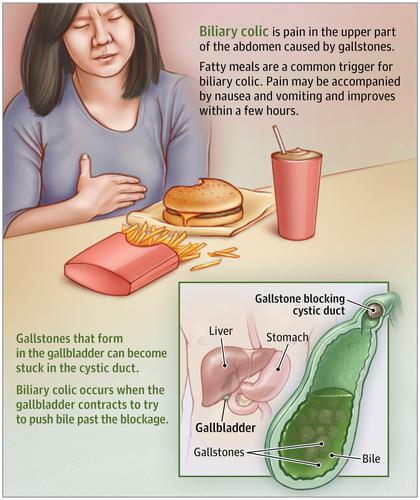JAMA ( IF 63.1 ) Pub Date : 2018-10-16 , DOI: 10.1001/jama.2018.11868 Ioana Baiu , Mary T. Hawn

|
Biliary colic is the pain caused by gallstones.
The gallbladder is a pouch the size of a lime that sits under the liver and stores bile. Bile is a dark green liquid composed of water, bile salts, and cholesterol that helps with digestion of food and absorption of fat and fat-soluble nutrients and vitamins. The liver continuously makes bile, which is then stored in the gallbladder and released when a meal is ingested. Sometimes, the cholesterol in bile can deposit and form thick crystals (sludge) or stones (gallstones). Being older than 40 years, female, rapidly losing or gaining weight, at increased weight, or pregnant are some of the risk factors for gallstones. One in 5 people have gallstones, but only one-third of patients with gallstones will ever have pain from them. Among all patients with gallstones, only 1% to 3% each year have complications.
When a meal is ingested, the gallbladder squeezes the bile into the small bowel to help digest fat. In this process, gallstones can get stuck in the thin duct (cystic duct) that connects the gallbladder to the main bile duct (common bile duct). As the gallbladder contracts to push the bile across the blockage, it can cause pain, nausea, and vomiting. This is a continuous pain felt mostly in the upper part of the abdomen, the back, or the right shoulder. If the stone is completely stuck and cannot be pushed into the small intestine, it can lead to gallbladder infection (cholecystitis), obstruction of the bile flow from the common bile duct (choledocholithiasis), or inflammation of the pancreas (gallstone pancreatitis). The type of complication depends on where exactly the stone is impacted.
中文翻译:

胆结石和胆绞痛
胆绞痛是胆结石引起的疼痛。
在胆囊是一个小袋,根据肝和胆店位于石灰的大小。胆汁是一种深绿色的液体,由水,胆汁盐和胆固醇组成,有助于食物的消化和脂肪以及脂溶性营养素和维生素的吸收。肝脏不断产生胆汁,然后将胆汁储存在胆囊中,并在进餐时释放出来。有时,胆汁中的胆固醇会沉积并形成厚厚的晶体(淤泥)或结石(胆结石))。年龄超过40岁的女性,体重迅速增加或减轻,体重增加或孕妇怀孕是胆结石的一些危险因素。五分之一的人患有胆结石,但只有三分之一的胆结石患者会因此而感到疼痛。在所有胆结石患者中,每年只有1%至3%会出现并发症。
进餐时,胆囊将胆汁挤入小肠以帮助消化脂肪。在这个过程中,胆结石可能会卡在薄管(胆囊管)连接胆囊到主胆管(胆总管)。胆囊收缩将胆汁推过阻塞部位时,会引起疼痛,恶心和呕吐。这是一种持续的疼痛,主要在腹部的上部,背部或右肩上感觉到。如果结石完全粘住并且无法推入小肠,则可能导致胆囊感染(胆囊炎),从胆总管流出的胆汁阻塞(胆总管结石病)或胰腺发炎(胆结石性胰腺炎)。并发症的类型取决于确切的位置在石头上受到影响。













































 京公网安备 11010802027423号
京公网安备 11010802027423号